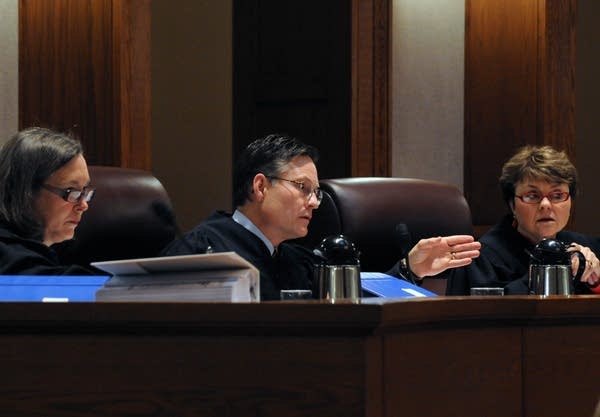Election official questioned on absentee decisions
Go Deeper.
Create an account or log in to save stories.
Like this?
Thanks for liking this story! We have added it to a list of your favorite stories.
[image]
Minnesota's U.S. Senate trial drilled deep into the details of the recount itself on Wednesday, with a lawyer for Republican Norm Coleman grilling a state election official on why some rejected absentee ballots were counted and some were not.
Coleman attorney Joe Friedberg questioned Deputy Secretary of State Jim Gelbmann for several hours, and elicited numerous examples of apparently inconsistent standards for deciding which absentees to count.
[image]
Turn Up Your Support
MPR News helps you turn down the noise and build shared understanding. Turn up your support for this public resource and keep trusted journalism accessible to all.
At one point, Friedberg asked Gelbmann, "People whose votes should have been counted have been disenfranchised, is that correct?"
"That is absolutely correct, yes," Gelbmann answered.
Gelbmann was quick to point out that election officials followed a process laid out by the Minnesota Supreme Court that allowed both candidates to veto some absentee ballots even after county officials had determined that they had been rejected unfairly.
During that phase of the recount, the campaigns agreed to count 933 rejected absentees out of 1,346 brought forward by county officials.
The effort to count up to several thousand rejected absentee ballots is the central goal of Coleman's lawsuit, which seeks to reverse a recount that has Democrat Al Franken on top by 225 votes.

Franken is arguing that the vast majority of absentee rejections were proper under state law, and that any mistakes were the result of simple human error.
Friedberg highlighted cases where absentee ballots rejected for a particular reason in one county were accepted in other counties even though they had a similar error.
For example, he asked Gelbmann about absentee ballots that were rejected because voters were not registered - even though in some cases the voter had enclosed their registration card inside the ballot's secrecy envelope. (Voters aren't supposed to do that; election officials ordinarily check a card against the sealed secrecy envelope.)
Gelbmann testified that some counties were able to determine the registration cards were inside the envelopes because they were on heavier paper stock than the ballots themselves. But that apparently didn't happen everywhere.
"We're dealing with a system run by human beings, and human beings make mistakes," Gelbmann said.
Franken's attorneys repeatedly objected to Friedberg's questions to Gelbmann. They said Friedberg was seeking answers on situations where Gelbmann did not have firsthand knowledge.
Coleman's attorneys have shifted ground on the number of absentees they want in the count, leading Franken's attorneys to accuse them of fishing for votes. Coleman's team said Wednesday they think the judges should inspect all of the remaining rejected absentees, estimated at between 11,000 and 12,000.
Those ballots are stored in Minnesota's 87 counties. The judges are expected to issue an order soon laying out how they will be brought to St. Paul. (Copyright 2009 by The Associated Press. All Rights Reserved.)


